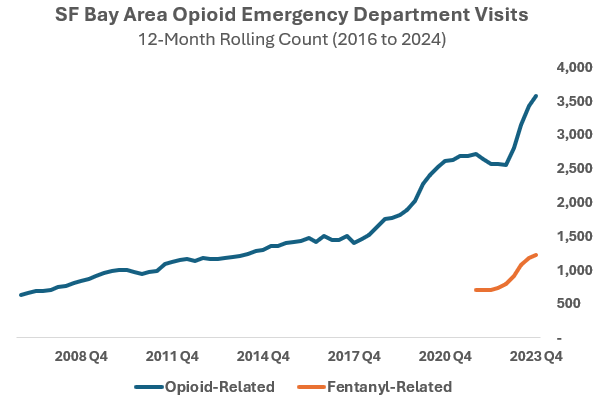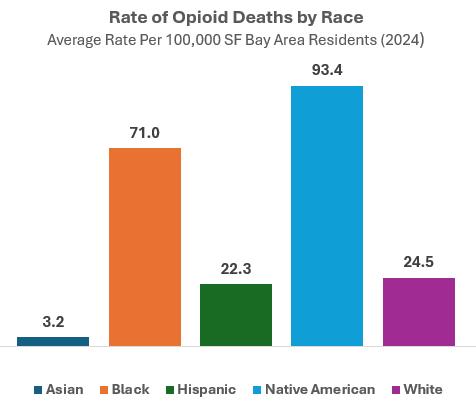Synthetic Killer: The Bay Area's 900% Spike in Opioid Deaths (Part IV)
As we conclude our four-part series on drugs and substance abuse with a particular focus on youth, we turn our attention to one of the most alarming threats of all: opioids. The rise in opioid-related deaths and emergency department visits in the Bay Area tells a sobering story about the devastating impact these substances are having on our communities.
What makes the current opioid crisis particularly dangerous is the prevalence of fentanyl in illicit drugs. This deadly synthetic opioid has become increasingly common in street drugs, leading to the Drug Enforcement Administration's stark warning: "One Pill Can Kill."
________________
The Fentanyl Factor
Fentanyl, a synthetic opioid approved by the FDA for pain relief, is approximately 100 times more potent than morphine—making even trace amounts potentially lethal. As depicted in the photo above, a deadly dose of fentanyl is smaller than a pencil tip, illustrating its extraordinary potency and danger.
The DEA reports alarming statistics:
In 2023, they seized over 80 million fentanyl-laced fake pills and nearly 12,000 pounds of powder—equivalent to 390 million lethal doses.
By early 2024, seizures already represented over 367 million deadly doses.
DEA testing shows half of all pills containing fentanyl have a potentially lethal dose.
Drug traffickers often create counterfeit pills disguised as legitimate medications and increasingly distribute them through social media and internet platforms, using temporary posts, emoji codes, and other tactics to avoid detection.
________________
The statistics from the California Department of Health paint a dark picture:
Opioid-related deaths have increased by nearly 900% from 2016 to 2024, rising from 144 deaths to 1,262.
This means 3-4 people in the Bay Area are dying from opioids every day
Perhaps most tellingly, over 95% of opioid deaths in the past year were fentanyl-related.
In the last five years, there has been a nearly 100% correlation between fentanyl-related deaths and opioid-related deaths.
There is, however, one glimmer of hope: current opioid-related deaths are down 12% from their peak in the third quarter of 2023.
________________
Emergency Department Visits
Emergency department visits tell a similar story:
Opioid and fentanyl-related ED visits have increased by over 560% since 2016.
In the last 12-month period, there were 3,575 opioid-related emergency department visits—the highest number on record.
Data collection on fentanyl-specific ED visits is relatively recent, making it difficult to draw definitive conclusions about these trends separately.
________________
Who Is Most Affected? Demographics of the Crisis
Examining the demographic patterns of opioid-related deaths reveals important insights about how this crisis is affecting different groups within Bay Area communities.
Age Distribution
People in their 30s represent the highest number of opioid-related deaths, followed by those in their 40s.
However, the crisis affects people of all ages, including children under 10 years old.
________________
Gender Differences
Mirroring national trends, the opioid crisis shows a significant gender disparity in mortality rates across the Bay Area region.
Males account for 77% of opioid deaths, compared to 23% for females.
________________
Racial Disparities
The opioid crisis affects all racial and ethnic groups, but not equally:
In absolute numbers, White individuals had the most deaths (695), followed by Hispanic individuals (385).
When adjusted for population size, however, significant disparities emerge:
Native Americans experience the highest rate of opioid-related mortality (93.4 deaths per 100,000)
Black individuals face the second highest rate (71 deaths per 100,000)
White and Hispanic individuals show intermediate rates
Asian Americans have the lowest rate (3.2 deaths per 100,000)
This nearly 30-fold difference between the highest and lowest affected groups highlights how unevenly the opioid crisis impacts different communities, even within the same geographic area.
________________
Signs of Hope
Despite the grim statistics, there are reasons for cautious optimism:
Narcan Saves Lives
Naloxone (commonly known by the brand name Narcan) can rapidly reverse opioid overdoses and prevent deaths:
Since October 2018, California has distributed more than 5.88 million naloxone kits.
These kits have been used in at least 341,197 reported drug reversal cases.
Increased Awareness and Enforcement
Law enforcement agencies are increasingly focusing on education and prevention alongside enforcement efforts.
Public awareness campaigns about the dangers of fentanyl are reaching more communities.
Prescription Reductions
Prescription opioids have declined by 49% from their peak level of 3.6 million in 2014.
This reduction helps decrease the initial risk of addiction that can lead to illicit opioid use.
________________
Conclusion
The opioid crisis, particularly the rise of fentanyl, represents a serious public health challenge facing the Bay Area today. The statistics are alarming: a 900% increase in deaths since 2016, with fentanyl playing a role in over 95% of recent opioid fatalities.
Yet even amid these sobering realities, there are signs of progress. The recent 12% decline from peak death rates, increased availability of life-saving naloxone, and reductions in prescription opioids all suggest that various efforts are making a difference.
As we conclude our four-part series on substance abuse, we find reasons for both hope and concern. Today's youth are consuming less alcohol and drugs overall compared to previous generations, though an increasing number of young adults report using substances for relaxation and stress relief. The most alarming development is that while use may be declining, the substances currently available are far more potent and dangerous than ever before. Education and prevention efforts remain crucial because youth and adults who experiment with drugs today face unprecedented risks from substances like fentanyl and high-potency cannabis products.








